Diacell Design Diamond Anvils
Force-fitted into anvil rings for mechanical stability, ease of replacement and cryogenic use
- Specific design for Almax easyLab's diamond anvil cells where diamonds are fitted mechanically in anvil rings.
- Optimised design with smaller height/base ratio for maximum sustainable load.
- Suitable for most Diacell® DACs (μScopeDACs, LeverDACs, CryoDACs, OmniDACs, Braggs (Be seat), HeliosDAC).
- Girdle ground 16-sided and crown ground conical for better symmetry and shorter lead times due to automation. Important to fit the anvil in anvil rings.
Description
The table below provides you with all the different diamond anvils of this type. You can narrow down your choice using the filters below.
If you are in doubt about the meaning of each filter, more explanation is available in each of the tabs above.
Product Number
| Diameter (mm)
| Material
| Application | |
|---|---|---|---|---|
2.50 |
Diamond Type IIas |
Optical Raman ⋅ X-Ray ⋅ FT-IR |
||
2.50 |
Diamond Type la |
Optical ⋅ X-Ray |
||
3.10 |
Diamond Type IIas |
Optical Raman ⋅ X-Ray ⋅ FT-IR |
||
3.10 |
Diamond Type la |
Optical ⋅ X-Ray |
||
2.00 |
Diamond Type IIas |
Optical Raman ⋅ X-Ray ⋅ FT-IR |
||
2.00 |
Diamond Type la |
Optical ⋅ X-Ray |
||
2.50 |
Diamond Type IIac |
Optical ⋅ FT-IR |
||
3.10 |
Diamond Type IIac |
Optical ⋅ FT-IR |
||
2.00 |
Diamond Type IIac |
Optical ⋅ FT-IR |
Diameter
There are 3 diameters for these anvils. Typical dimensions are shown in the table below. The choice will be dictated by the type of diamond anvil cells from Almax easyLab you have :
|
3.10 mm Diacell Design HeliosDAC OmniDAC OmniDAC LT Diaclamp CryoDAC Mega |
2.50 mm Diacell Design CryoDAC-LT, CryoDAC-ST CryoDAC Nitro, CryoDAC PPMS µScopeDAC-RT(G), HT(G), HT(S) LeverDAC – Mega, Maxi, Mini SymmDAC, VivoDAC |
2.00 mm Diacell Design CryoDAC Tesla
|
Material
| Diamond Type Ia | ~2×10³ ppm of nitrogen – yellow |
| Diamond Type Ia – Raman low / ultra-low fluorescence | ~2×10³ ppm of nitrogen – white to light yellow |
| Diamond Type IIac | ~1 ppm of nitrogen – white to light brown |
| Diamond Type IIas – Raman ultra-low fluorescence & ultra-low birefringence | ~1 ppm of nitrogen – white |
Almax easyLab is committed to its policy of continuous improvement. Specifications may change without notice. easyLab and Diacell are registered trademarks of Almax easyLab.
FT-IR Spectrum
 |
 |
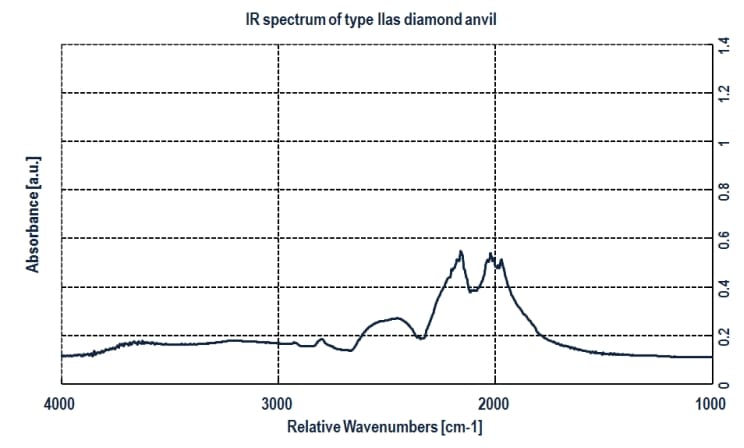 |
FLUORESCENCE
Almax easyLab can select its diamonds for low fluorescence. Standard measurements include laser excitation at 532 nm and covers fluorescence background in the range of 542 to 608 nm (Raman shifts between 1000 and 3000 cm-1). Measurements for different wavelength ranges can be made available on request. In special cases customers can select their own diamonds for low fluorescence using their own measurement set-up.
Almax easyLab classifies its diamonds with respect to fluorescence according to the following criteria:
- Type Ia UV low fluorescence – Checked with a UV lamp
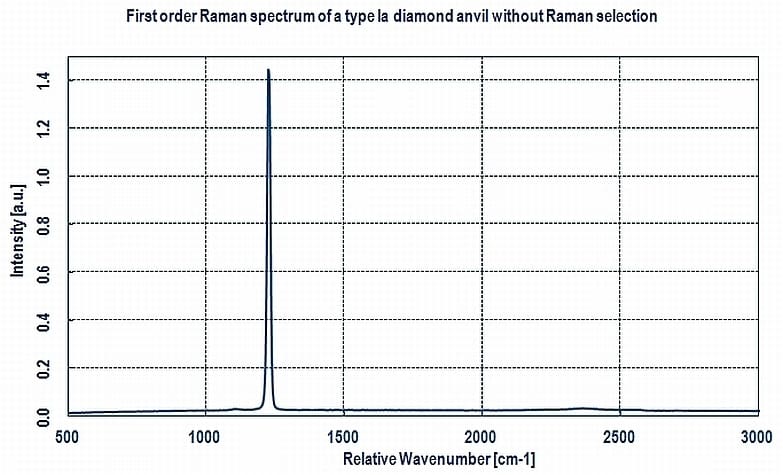 |
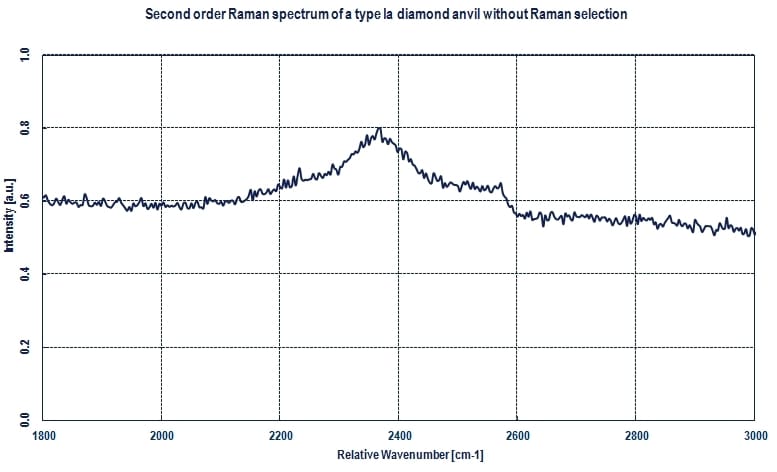 |
- Type Ia Raman low fluorescence – The intensity of the two-phonon Raman transition at 2664 cm-1 is at least 1.25 times the intensity of the background fluorescence of diamond
 |
 |
- Type Ia Raman ultra-low fluorescence – The intensity of the two-phonon Raman transition at 2664 cm-1 is at least 2 times the intensity of the background fluorescence of diamond
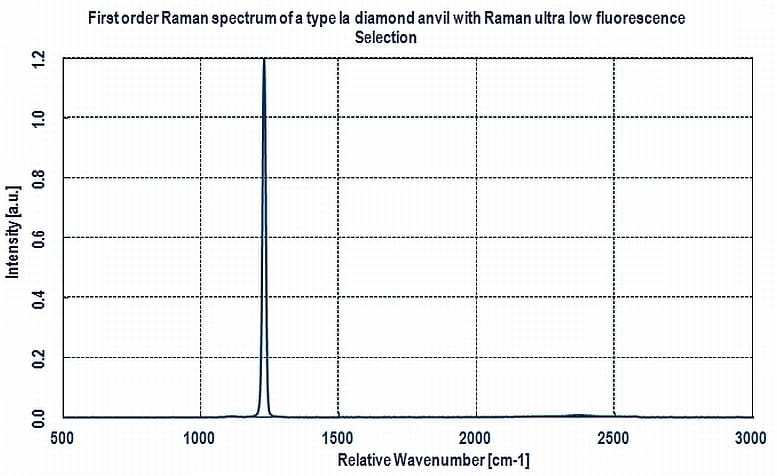 |
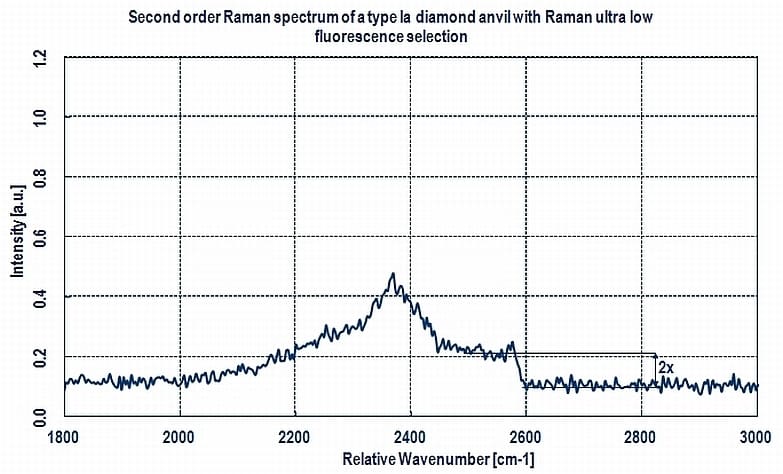 |
- Type IIac Raman ultra-low fluorescence
 |
 |
- Type IIas Raman ultra-low fluorescence – The intensity of the two-phonon Raman transition at 2664 cm-1 is at least 5 times the intensity of the background fluorescence of diamond
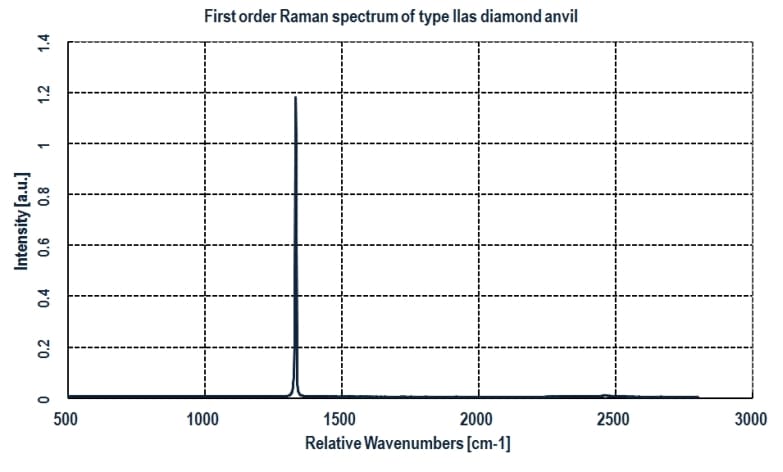 |
 |
BIREFRINGENCE
All diamonds to be used for anvil manufacture are examined under a polarising microscope for birefringence. Diamonds with significant birefringence discontinuity, typical of inclusions, etc. are rejected. In addition diamonds can be selected for ultralow birefringence. Total birefringence is measured using crossed polarisers, a waveplate and matched to specifications. Normally:
- Low birefringence <0.0001
- Ultra low birefringence <0.00005
Application
The Diacell design diamond anvils can be used both for optical spectroscopy and for X-ray diffraction measurements. Force-fitted into anvil rings these anvils are characterized by mechanical stability and ease of replacement. Moreover using anvil rings has the advantage of avoiding the use of epoxy resins or other adhesives, all of which tend to be unreliable at very low temperatures.
These anvils can be used in conjunction with:
Almax easyLab diamond anvil cells:
Optical: CryoDAC-ST, CryoDAC-LT, CryoDAC Nitro, CryoDAC Mega, µScopeDAC-RT(G), µScopeDAC-HT(G), µScopeDAC-HT(S), SymmDAC
X-ray: HeliosDAC, OmniDAC, OmniDAC-LT, Diaclamp
Electrical: CryoDAC PPMS
Magnetic: Mcell Ultra
Newly designed or existing DACs (retrofit):
In most cases, the WC seat can be adapted to the dimension requirements of your DAC. Consult us.
Documents
We have compiled a series of technical documents (brochures, articles, technical drawings, …) which you might find useful to help you understand this product better.
Technical documentation
Gridle and Crown Ground (ML23_06)
Type IIam diamond anvils for multi-megabar pressures (ML23_07)
Brochure Type IIas Diamond Anvils Extended
Brochure Type IIac Diamond Anvils Extended
FAQs
How to chose the culet size ?
The culet size is to be decided as a function of the maximum pressure or the sample size. Typical sample space is given by the gasket thickness (typically 0.10 mm or less) and the central hole diameter (typically 30-50% culet size)
| Pmax (GPa) (*) | < 5 | 5-100 | > 100 |
| Culet size (mm) | > 1.00 | 1 -0.20 | < 0.20 mm, bevels up to 0.30 mm at 8° |
(*) The Pmax values are only indicative. The maximum pressure achievable with a DAC is influenced by many others experimental parameters, like the gasket characteristics (material, thickness and hole size) or the pressure transmitting medium.
How the culet looks like?
| Culet flat | Culet with single bevel | Culet with double bevel |
 |
 |
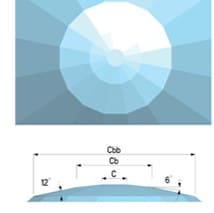 |
Examples of typical requests for quote:
Diamond anvil, type Ia, Diacell design, 16-sided, 2.50 mm, culet of 0.10 mm, bevels up to 0.30 at 8°, (100)-oriented:
- Article nr.: P00131
- Quantity: 6 anvils
Diamond anvil, type IIas, Diacell design, 16-sided, 3.10 mm, culet of 0.30 mm, (100)-oriented:
- Article nr.: P01934
- Quantity: 4 anvils


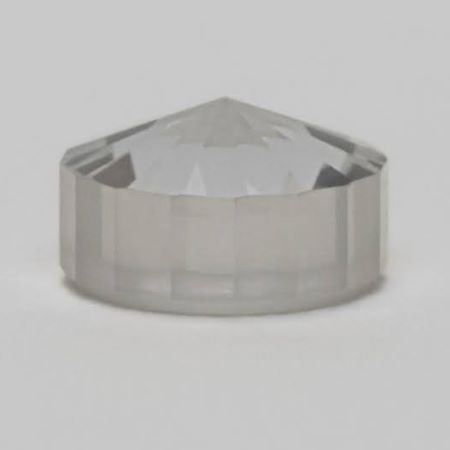
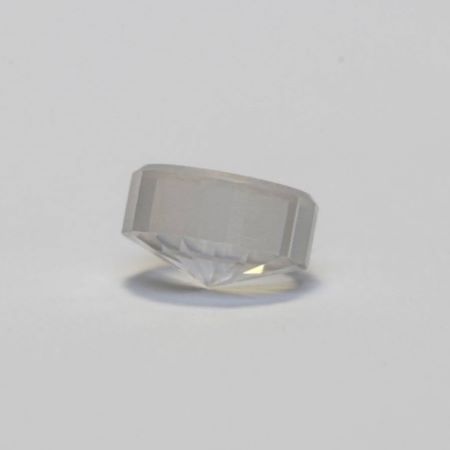
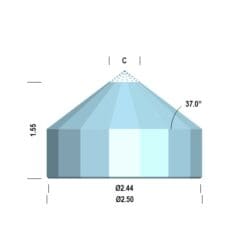
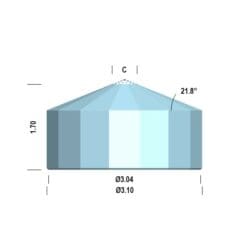
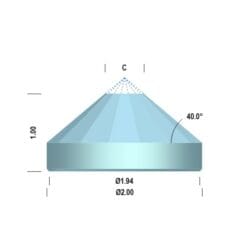
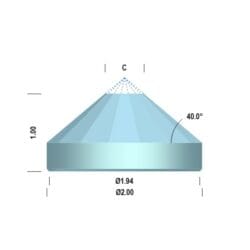
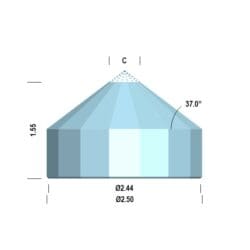







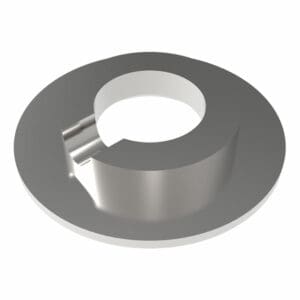

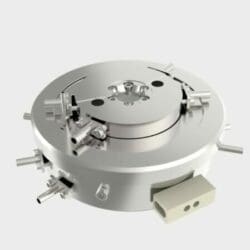
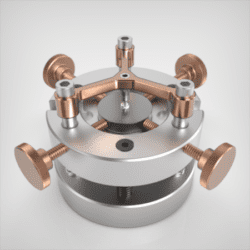
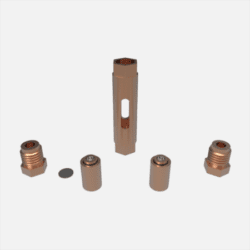
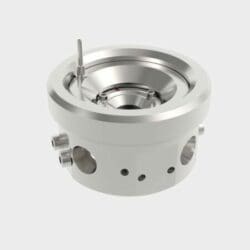
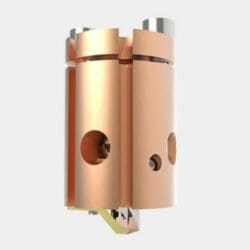

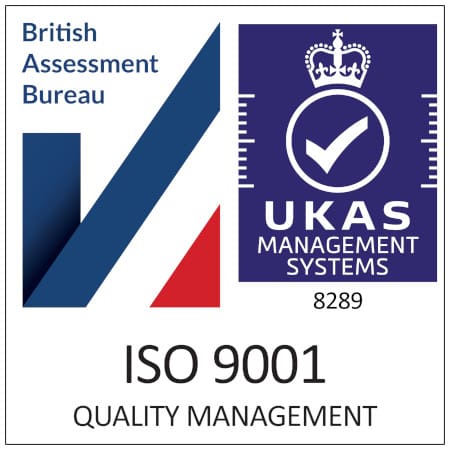
Reviews
There are no reviews yet.